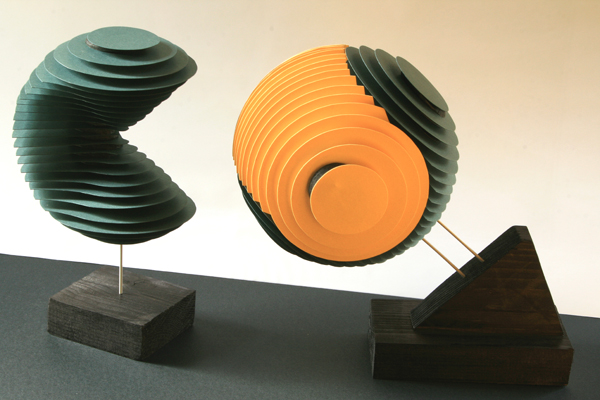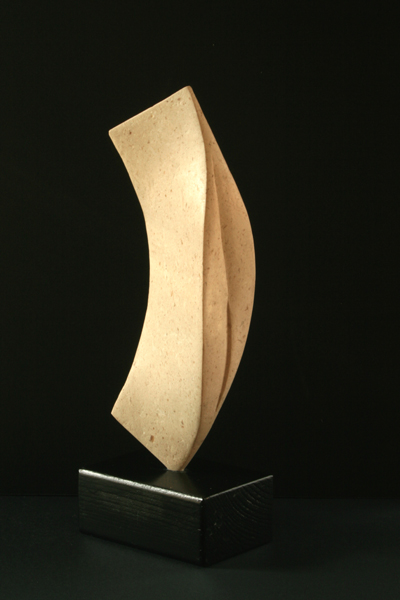Wim van den Camp
freelance artist
"Until now, I am working in/with hard stone, wood and paper, if possible without using heavy equipment. In my art I use mathematical principles and shapes for creating beautiful spatial objects. In this, simplicity is very important. Dividing objects in (congruent) parts fascinates me. In stone and in wood I also am making work which is less mathematically orientated. In working with paper, apart from the mathematical content, also the vulnerability of the material and of the objects is inspiring me. At the moment in objects from paper I am working on a cube project: cubes (made of a folding net in one piece), with something special. In stone I am working at two exciting 3D objects, fit for a tessellation of R3."
“Sphere, intersected by cones. (Bol, gesneden door kegels) ”
2008, (ply)wood, knitting needle, 1.5 Sphere of radius 2.8" in showcase 12"x12"x12"
Think of a conic surface with top corner 90 degrees and vertical axis, cut in two by plane P, containing the axis of the cone. P is from front to back. Rotate the right half of the cone surface around an axis, perpendicular to P, through top T of the cone. Situate the midpoint of a sphere in point T. The conic surface cuts the sphere into two congruent parts; the border line looks like the white curve on a tennis ball. In the left part of the sphere, make horizontal intersections at half centimeters distance, starting in the middle.
“ Sphere, intersected by half circles. (Bol,
gesneden door halve cirkels)
”
2008, Paper, (ply)wood, knitting needle, 1.5 Sphere of radius 2.8" in
showcase 12"x12"x12"

Imagine a massive tennis ball with white winding of four half circles, two horizontally to the right, two vertically to the left. Move the upper horizontal half circle by letting the two endpoints follow the vertical half circles. Keep the moving half circle horizontally. The sphere is now divided in two congruent parts. In the left part of the sphere, make horizontal intersections at half centimeters distance, starting in the middle.
“ Standing wave (Staande golf) ”
2007, Bianco del mare, wood, 2.6"x4.2"x11.2"

The curved shape has sides whose vertical borders are sinusoids, giving this object a very suggestive vaulting.
“ Hermit (Heremiet)”
2006, Belgian fossil, 3"x4.5"x15"

The column exists of a rectangular top, 4.5x3'', diminishing regularly to 3x2''. The longest side above and the final shortest side are situated in the same vertical plane. The upper right front corner point never leaves this plane. All horizontal intersections are similar. Downwards the process is inverted, but not completely, giving the object a more exciting shape. In the top, a hermit crab is hiding.